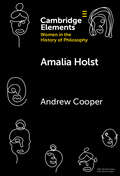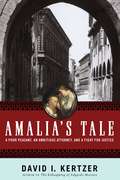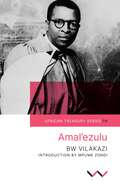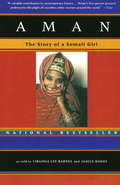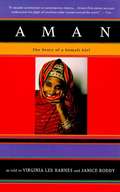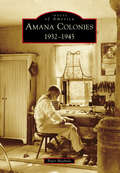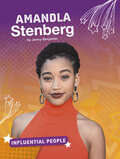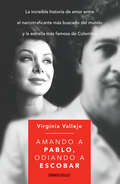- Table View
- List View
Amalia Holst (Elements on Women in the History of Philosophy)
by Andrew CooperAmalia Holst's trailblazing book On the Vocation of Woman to Higher Intellectual Education (1802) dropped a bomb on the German speaking states-a bomb that failed to detonate. In one of the first works of philosophy in German published under a woman's name, Holst declares that it is time a member of the female sex spoke out about the plight of women in Germany. Despite her bold attempt to ignite a new movement of women's education, her book was harshly reviewed by male critics and thrust into obscurity. This Element presents the first comprehensive study of Holst's writings, unearthing their striking contribution to philosophy's growing awareness of the social conditions of human freedom. The force of her argument, and the difficulties she encountered, reveal the ambiguous character of the German Enlightenment and prompt us to reconsider what can be salvaged from it.
Amalias Tale
by David I. KertzerThis quintessential David-and-Goliath saga tells the story of a wholly unexpected triumph of the poor against the rich and of a crusading city attorney who fought on behalf of an impoverished peasant. Amalia Bagnacavalli, an illiterate young peasant from the mountains near Bologna, is forced by poverty to take in a child from the city’s foundling home to wet-nurse. When Amalia contracts syphilis from the sickly and malformed baby given to her, the city fathers callously dismiss her pleas for treatment and restitution. Bewildered and frightened, she seeks out Augusto Barbieri, an ambitious attorney looking to make a name for himself. He takes up Amalia’s cause, fighting the case for years through the Italian courts before winning an unprecedented and stunning victory for his by now broken client. The unforgettable story of a landmark struggle for basic human rights, Amalia’s Tale is the moving drama of a rural woman whose life was ruined and the man from the city who would not stop -- or so it seemed -- until he had seen justice done.
Amalita: La biografía
by Soledad Vallejos Marina AbiusoBiografía de Amalia Lacroze de Fortabat, la mujer más rica de laArgentina. Una historia de política, dinero y amor llena de datos sorprendentes. «No habrá ninguna igual», así la despidieron las mujeres de su familia cuando murió, en febrero de 2012. La mujer más rica de la Argentina, la viuda convertida en empresaria cementera de la noche a la mañana, fue tan poco común como su historia. Amalia Lacroze de Fortabat podía ponerse al frente de su propio equipo de fútbol profesional con la misma naturalidad con la que mandaba en la compañía cementera que había heredado de su marido, almorzaba con presidentes (democráticos o no) o se hacía retratar por Andy Warhol. Hija de una familia patricia, con mucho prestigio social pero no tanta fortuna económica, era una veinteañera casada con un abogado cuando conoció a Alfredo Fortabat, el industrial -también casado- capaz de sacar millones de las piedras. Divorciados, en segundas nupcias formaron un matrimonio donde los negocios, el amor y la política fueron de la mano. Tras enviudar, Amalita hizo de sí misma una leyenda, sin importar si la verdad sufría en el camino. De su mano, Loma Negra creció aunque se sucedieran los gobiernos. Hubo contratiempos: un juicio millonario por estafa al Estado y la investigación por la desaparición de un abogado en 1977. Prestó su avión para la guerra y ayudó a los ex combatientes de Malvinas, desarrolló una fuerte tarea de acción social con su fundación y se concedió todos los caprichos: una radio, un diario, los hombres que quiso. Amalita es el resultado de una intensa y rigurosa investigación periodística. Es el producto de haber entrevistado a quienes la conocieron y trataron en los más diversos ámbitos, pero también de una obsesiva tarea de archivo. Marina Abiuso y Soledad Vallejos han escrito una maravillosa biografía repleta de secretos; como su protagonista, una mujer que sorprendió hasta en su último acto: vender la empresa que la hizo famosa. En su final, conservó el dinero, no el poder.
Amal’ezulu
by Benedict Wallet VilakaziAmal’ezulu (Zulu Horizons), first published in 1945 in the Bantu (later, African) Treasury Series by the University of the Witwatersrand Press, was the second volume of poetry produced by the renowned Zulu author B.W. Vilakazi. It was written during the ten years he spent living in Johannesburg, in ‘exile’ from his birthplace, KwaZulu-Natal. The poems in this collection represent a turning point in Vilakazi’s life; they express yearnings for the beloved land, animals and ancestral spirits of his rural home, as well as expressions of deep disillusionment with the urban life he encountered in the ‘City of Gold’, and in particular the suffering of the black miners who brought this gold to the surface but never experienced the benefits of the wealth it produced for the mine owners. Vilakazi was deeply conscious of the subhuman system that held these miners in its grip, and gave voice to their suffering in many of the poems in the collection, in particular the now famous poem ‘Ezinkomponi’ (‘On the mine compounds’).Renowned as the father of Nguni literature, Vilakazi was both a traditional imbongi (bard) and a forward-looking poet who could fuse Western poetic forms with Zulu izibongo (praise poetry). In these poems he assumes the role of the voice of the voiceless, and gives poignant expression to the stoic endurance of those caught up in the brutalities of capitalist exploitation of African labour, and the appalling injustices of the migrant labour system.
Aman
by Virginia Lee Barnes Janice BoddyThis is the extraordinary first-person account of a young woman's coming of age in Somalia and her struggles against the obligations and strictures of family and society. By the time she is nine, Aman has undergone a ritual circumcision ceremony; at eleven, her innocent romance with a white boy leads to a murder; at thirteen she is given away in an arranged marriage to a stranger. Aman eventually runs away to Mogadishu, where her beauty and rebellious spirit leads her to the decadent demimonde of white colonialists. Hers is a world in which women are both chattel and freewheeling entrepreneurs, subject to the caprices of male relatives, yet keenly aware of the loopholes that lead to freedom. Aman is an astonishing history, opening a window onto traditional Somali life and the universal quest for female self-awareness. From the Trade Paperback edition.
Aman
by Virginia Lee Barnes Janice BoddyThis is the extraordinary first-person account of a young woman's coming of age in Somalia and her struggles against the obligations and strictures of family and society. By the time she is nine, Aman has undergone a ritual circumcision ceremony; at eleven, her innocent romance with a white boy leads to a murder; at thirteen she is given away in an arranged marriage to a stranger. Aman eventually runs away to Mogadishu, where her beauty and rebellious spirit leads her to the decadent demimonde of white colonialists. Hers is a world in which women are both chattel and freewheeling entrepreneurs, subject to the caprices of male relatives, yet keenly aware of the loopholes that lead to freedom. Aman is an astonishing history, opening a window onto traditional Somali life and the universal quest for female self-awareness. From the Trade Paperback edition.
Aman Resorts
by Aldo Sesia Eugene SoltesAman Resorts describes the operating model and philosophy of this high-end set of global properties. Aman relies on employees taking considerable initiative to deliver the highest quality personalized service in the hospitality industry. The case also highlights Aman's strategy and operations which differ in many ways from industry standards.
Aman Resorts (B)
by Aldo Sesia Eugene SoltesAman Resorts (B) describes how employees are rewarded and compensated which is used to supplement Aman Resorts (A).
Aman: The Story of a Somali Girl
by Virginia Lee Barnes Janice BoddyThis is the extraordinary first-person account of a young woman's coming of age in Somalia and her struggles against the obligations and strictures of family and society. By the time she is nine, Aman has undergone a ritual circumcision ceremony; at eleven, her innocent romance with a white boy leads to a murder; at thirteen she is given away in an arranged marriage to a stranger. Aman eventually runs away to Mogadishu, where her beauty and rebellious spirit leads her to the decadent demimonde of white colonialists. Hers is a world in which women are both chattel and freewheeling entrepreneurs, subject to the caprices of male relatives, yet keenly aware of the loopholes that lead to freedom. Amanis an astonishing history, opening a window onto traditional Somali life and the universal quest for female self-awareness.
Amana Colonies: 1932-1945 (Images of America)
by Peter HoehnleThe Amana Colonies were founded by members of the Community of True Inspiration, a Pietist sect that originated in southwest Germany in 1714. Beginning in 1842, members of the sect migrated to New York and founded the Eben-Ezer Society, in which land, shops, and homes were owned communally. Members worked at assigned jobs, attended 11 church services each week, and received food, clothing, and shelter. Beginning in 1855, the community relocated to a 26,000-acre tract in eastern Iowa, where they founded the seven Amana villages, each with its own church, school, general store, craft shop, and barns. A disastrous fire, economic downturns, and a growing dissatisfaction with communal life led the members to vote to reorganize as a separate business and church organization in 1932. Images of America: Amana Colonies: 1932-1945 examines a time when the Amana people worked to preserve aspects of their traditional religious and cultural life while, simultaneously, learning to embrace American life and the waves of people who visited these unique villages in growing numbers.
Amanco: Developing the Sustainability Scorecard
by Robert S. Kaplan Ricardo Reisen de PinhoDescribes the challenges of using the Balanced Scorecard to implement a triple-bottom-line strategy for delivering excellent economic, environmental, and social performance. The owners and senior executive team of Amanco, a producer of plastic pipe and complete water treatment systems, want strong financial returns but are also deeply committed to improving the environment and making a difference in people's lives. Robert Salas, CEO, wants a management system that communicates and motivates Amanco's three high-level goals. Initially, he creates a simple scorecard of measures, but he soon migrates to developing a strategy map and Balanced Scorecard that places economic, environmental, and social objectives as the highest-level objectives. He faces the challenges of cascading the corporate Balanced Scorecard to operating units throughout Latin America and how to develop better measures of social and environmental impact. Salas must also address whether he can sustain Amanco's balanced strategy while entering the Brazilian market, where he faces an entrenched and much larger competitor.
Amanda Gorman (Biographies Ser.)
by Jehan Jones-RadgowskiHow much do you know about Amanda Gorman? Find out the facts you need to know about this impressive young poet. You’ll learn about the childhood, challenges, and accomplishments of this rising star.
Amanda and Kristen: Mented Cosmetics
by Steven Rogers Alterrell MillsCase - The case highlights the two co-founders (black HBS alumnae) of a black-owned beauty startup and the unmet needs within the beauty industry. This case study examines the entrepreneurial opportunities that come from identifying an underserved market, specifically within the black community. Students learn approaches to product ideation/innovation, marketing strategies for the social media age and launching a startup for a targeted audience. Students learn to analyze macro and micro economic data of an industry, synthesize consumer demographics and purchase behavior data, and create pro forma financial documents to determine the potential economic opportunity that is unmet in a market and the requisite fundraising to launch a new business. Mented co-founders became the 15th and 16th African-American women to raise over $1 million in startup funding.
Amanda and Kristen: Mented Cosmetics
by Steven Rogers Jeffrey J. BussgangThe co-founders (Black HBS alumnae) of an e-commerce beauty startup explore the unmet needs within the beauty industry. This case study examines the entrepreneurial opportunities that come from identifying an underserved market, specifically within the Black community and the best startup financing approach to pursue those opportunities. Students learn approaches to product ideation/innovation, marketing strategies for the social media age and launching a startup for a targeted audience. Students learn to analyze macro and micro economic data of an industry, synthesize consumer demographics and purchase behavior data, and create projected unit economics as well as pro forma financial documents to determine the potential economic opportunity that is unmet in a market and the requisite fundraising to launch a new business. At the time of the case, Mented co-founders went on to become the 15th and 16th African-American women to raise over $1 million in startup funding.
Amandla Capital: Real Estate in C te d'Ivoire
by John D. Macomber Pippa Tubman Armerding Dilyana BothaThis case describes Amandla Capital, a fledgling company in Cote d'Ivoire, facing three opportunities in the real estate and hospitality industries in Africa. It introduces students to several concepts: decision making and cost-benefit analysis in real estate, corporate strategy selection, management of stakeholders with varied needs and levels of sophistication, dealing with conflicts of interest, basics of hospitality and hotel management industries.
Amandla Stenberg (Influential People Ser.)
by Jenny BenjaminAmandla Stenberg had her first big break as Rue in the 2012 The Hunger Games movie. She is an actress, musician, writer, and activist. Learn more about how Amandla Stenberg is using her voice to make a difference!
Amando
by Adamari LopezAdamari vuelve a abrir las puertas de su corazón para compartir el torbellino emocional de los últimos años, donde al final de un túnel iluminado solo por la fe, la esperanza y el amor, encontró su milagro, su sueño hecho realidad. Luego de compartir por primera vez las angustias, el dolor y las ganas de vivir que yacían detrás de su sonrisa en Viviendo, después de confesar lo que sufrió y logró superar, desde un cáncer y un corazón partido hasta la pérdida de su querida mamá, Adamari ahora regresa para revelar los detalles más íntimos del último capítulo de su vida en Amando. ¿Qué hizo Adamari con su segunda oportunidad de vida? Salió en busca de sus sueños y, a pesar de enfrentar obstáculos nuevos e inesperados, no se dio por vencida. Ha sido un viaje emocionante y turbulento, con momentos de felicidad absoluta y tristeza devastadora. Con estas páginas colmadas de lágrimas y alegría, Adamari nos enseña que con fe, esperanza y amor, todo se llena de luz y se vuelve posible. En esta segunda oportunidad de vida, las pruebas y los miedos nuevamente acapararon el día a día de Adamari, mas no la paralizaron. Siguió viviendo, sonriéndole a la vida, luchando por sus sueños, y ese deseo de ser madre, que muchos le dijeron era prácticamente inalcanzable, se transformó en el milagro de su vida.
Amando a Pablo, odiando a Escobar
by Virginia Vallejo¡Pronto en la gran pantalla! En julio de 2006 un avión de la DEA sacó a Virginia Vallejo de Colombia. Su vida estaba en peligro por haberse convertido en el testigo clave de los dos procesos criminales más importantes de la segunda mitad del siglo XX en su país: el asesinato de un candidato presidencial y el holocausto del Palacio de Justicia. Veinticinco años antes, Virginia Vallejo era la presentadora de televisión más importante de Colombia y la belleza profesional que aparecía en las portadas de las principales revistas. Cortejada por multimillonarios tradicionales, conoció en 1982 a Pablo Escobar, un misterioso político de treinta y tres años que en realidad manejaba los hilos de un mundo de riqueza inigualable en el que gran parte del incesante flujo de dinero procedente del tráfico de cocaína se canalizaba a proyectos de caridad y a las campañas de candidatos presidenciales de su elección. Este libro, una apasionada historia de amor convertida en crónica del horror y la vergüenza, describe la evolución de una de las mentes criminales más siniestras de nuestro tiempo: su capacidad de infundir terror y generar corrupción, los vínculos entre sus negocios ilícitos y varios jefes de estado, los asesinatos de candidatos presidenciales y la guerra en que sumió a su país. Amando a Pablo, odiando a Escobar es también la única visión íntima posible del legendario barón del narcotráfico, plena de glamour y espíritu de supervivencia y no exenta de humor. Virginia Vallejo narra esta historia descarnada como nadie más podría haberlo hecho.
Amando a Pablo, odiando a Escobar
by Virginia VallejoAmando a Pablo, Odiando a Escobar cuenta desde la intimidad la historia del narcotraficante más poderoso de todos los tiempos: Pablo Escobar, el creador de los cárteles. Virginia Vallejo, quien fuera su amante y compañera durante más de cuatro años, narra una historia que nadie más podía haber contado. La increíble historia de amor entre el narcotraficante más buscado del mundo y la estrella más famosa de Colombia En julio de 2006 un avión de la DEA sacó a Virginia Vallejo de Colombia. Su vida estaba en peligro por haberse convertido en el testigo clave de los dos procesos criminales más importantes de la segunda mitad del siglo XX en su país: el asesinato de un candidato presidencial y la toma del Palacio de Justicia, donde fallecieron alrededor de cien personas, entre magistrados, guerrilleros y civiles. Veinte años atrás, Virginia Vallejo era la presentadora de televisión más popular de Colombia y la celebridad que aparecía en las portadas de las principales revistas. Cortejada por multimillonarios, conoció en 1982 a Pablo Escobar, un misterioso político de treinta y tres años que en realidad manejaba los hilos de un mundo de riqueza inigualable, en el que gran parte del incesante flujo de dinero procedente del tráfico de cocaína se canalizaba a proyectos de caridad y a las campañas de candidatos presidenciales de su elección. Este libro, una apasionada historia de amor convertida en crónica del horror y la vergüenza, describe la evolución de una de las mentes criminales más siniestras de nuestro tiempo: su capacidad de infundir terror y generar corrupción, los vínculos entre sus negocios ilícitos y varios jefes de Estado, los asesinatos de candidatos presidenciales y la guerra en que sumió a su país. Amando a Pablo, odiando a Escobar es también la única visión íntima posible del legendario barón del narcotráfico, plena de glamour y espíritu de supervivencia, y no exenta de humor. Virginia Vallejo narra esta historia descarnada como nadie más podía haberlo hecho.
Amando a Pablo, odiando a Escobar: Odiando A Escobar (Vintage Espanol Ser.)
by Virginia Vallejo¡PRONTO EN LA GRAN PANTALLA!En julio de 2006 un avión de la DEA sacó a Virginia Vallejo de Colombia. Su vida estaba en peligro por haberse convertido en el testigo clave de los dos procesos criminales más importantes de la segunda mitad del siglo XX en su país: el asesinato de un candidato presidencial y el holocausto del Palacio de Justicia.Veinticinco años antes, Virginia Vallejo era la presentadora de televisión más importante de Colombia y la belleza profesional que aparecía en las portadas de las principales revistas. Cortejada por multimillonarios tradicionales, conoció en 1982 a Pablo Escobar, un misterioso político de treinta y tres años que en realidad manejaba los hilos de un mundo de riqueza inigualable en el que gran parte del incesante flujo de dinero procedente del tráfico de cocaína se canalizaba a proyectos de caridad y a las campañas de candidatos presidenciales de su elección.Este libro, una apasionada historia de amor convertida en crónica del horror y la vergüenza, describe la evolución de una de las mentes criminales más siniestras de nuestro tiempo: su capacidad de infundir terror y generar corrupción, los vínculos entre sus negocios ilícitos y varios jefes de estado, los asesinatos de candidatos presidenciales y la guerra en que sumió a su país. Amando a Pablo, odiando a Escobar es también la única visión íntima posible del legendario barón del narcotráfico, plena de glamour y espíritu de supervivencia y no exenta de humor. Virginia Vallejo narra esta historia descarnada como nadie más podría haberlo hecho.
Amaphulo enkomo yodumo
by Danielle Bruckert – TRANSLATED BY Ntombizodwa Gxowa-DlayedwaIsixhosa – First words
